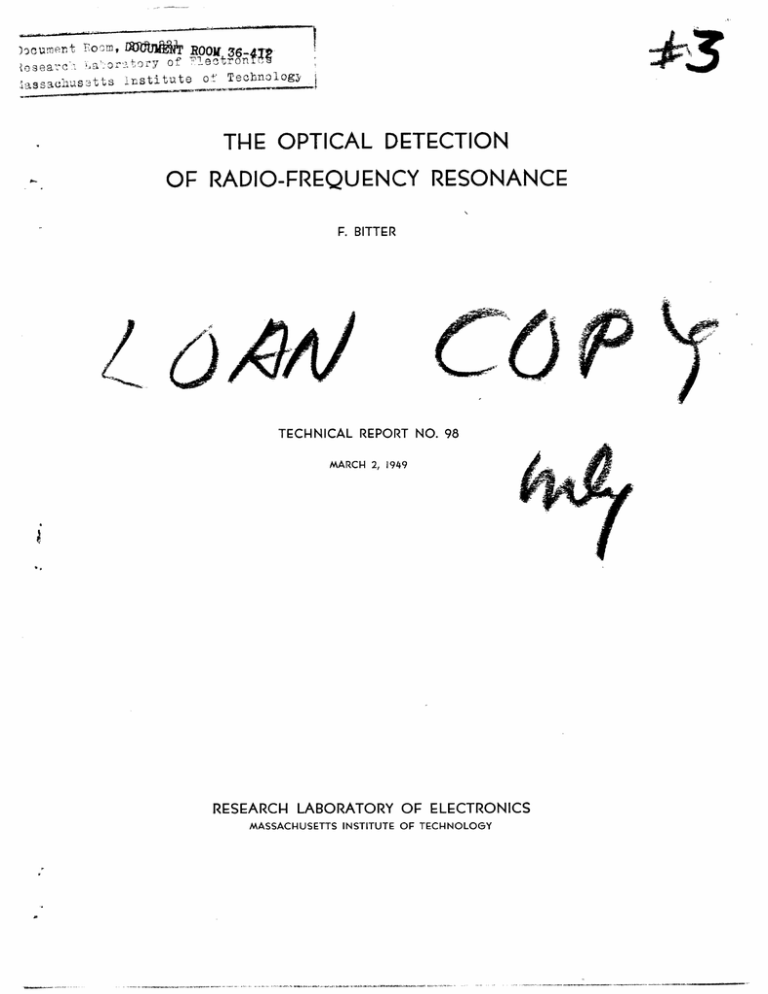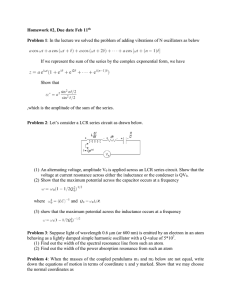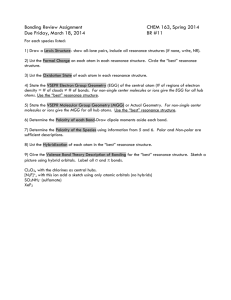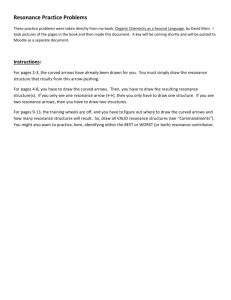*3 OA/IA THE OPTICAL DETECTION OF RADIO-FREQUENCY RESONANCE
advertisement

ROOM 36-4I~
)ocueert; Eoo, ;>Qi
of 7e70tronf
i-osea c:- :' 3t~--ttery
.^assa'ahusr~tts irstitute o Technoog~
.,,.
-
-
*3
;
_
THE OPTICAL DETECTION
OF RADIO-FREQUENCY RESONANCE
F. BITTER
"'
OA/IA .
C
TECHNICAL REPORT NO. 98
MARCH 2, 1949
RESEARCH LABORATORY OF ELECTRONICS
MASSACHUSETTS INSTITUTE OF TECHNOLOGY
The research reported in this document was made possible
through support extended the Massachusetts Institute of Technology, Research Laboratory of Electronics, jointly by the Army
Signal Corps, the Navy Department (Office of Naval Research)
and the Air Force (Air Materiel Command), under Signal Corps
Contract No. W36-039-sc-32037, Project No. 102B; Department
of the Army Project No. 3-99-10-022.
MASSACHUSETTS INSTITUTE OF TECHNOLOGY
Research Laboratory of Electronics
Technical Report No. 98
March 2, 1949
THE OPTICAL DETECTION OF RADIO-FREQUENCY RESONANCE
F. Bitter
P)
ABSTRACT
Calculations are made of the frequency, intensity, and polarization
of the light emitted by an atom in a doublet P to a doublet S tranxition
in a weak magnetic field having an oscillating component. Near resonance, or when the frequency of the oscillating component approaches the
Larmor frequency of one of the two states involved in the radiation process, all of the quantities calculated are modified. Qualitatively
similar results are to be expected for other transitions. Observations
in very weak fields would be of particular interest because they would
give information on nuclear as well as atomic g-factors.
Under such conditions, the Zeemann components will in general not be resolvable, and
the only observable effect will be a change in the polarization of the
edges of a spectral line at resonance. It is further shown that very
small changes in this polarization structure are theoretically detectable.
__
I
__
_L
I
__
_·
*
I
-4
THE OPTICAL DETECTION OF RADIO-FREQUENCY RESONANCE
The hope of drastically extending our knowledge of nuclear spins and
g-factors lies in further application of the resonance method, i.e., the
direct measurement of the spacing between the hyperfine-structure components
of an energy level.
A new method is here proposed to detect the condition
of resonance when it is established - namely a change in the radiation
emitted by an atom when it is subjected to an oscillating field at the resonance frequency in the above sense.
For simplicity, the discussion is confined to the resonance line
(doublet P to doublet S transition) of an atom having one optical electron,
The reso-
and it is further assumed that there is no hyperfine structure.
nance to be investigated is that corresponding to the Larmor frequency of
the system in very weak fields, or, in other words, corresponding to the
Zeemann splitting of one of the levels concerned.
Although this discussion
specifically excludes nuclear effects, it is clear that any method of following the ordinary Zeemann effect into the region of very weak fields will
produce information about nuclear moments when the Zeemann splitting becomes
of the same order of magnitude as any hyperfine structures which may exist.
The wave functions describing an atom in a magnetic field having an
They are the solutions of the
oscillating component are known (1).
Schroedinger time-dependent equation, and contain one arbitrary constant
which is usually so chosen as to define the initial state of the system.
In an atomic-beam experiment, for instance, this constant specifies the state
of the system when it enters the oscillating field, and the solution makes it
possible to specify the probability of finding the system in any particular
state at any subsequent time. The problem here proposed is physically somewhat different.
Consider a gas of the atoms under consideration at extreme-
ly low pressures so that collision effects may be neglected. All the atoms
in the container holding the gas are subjected to the same field. In this
case, the arbitrary constant in the wave function of the atoms in the ground
state must be so chosen that, if the oscillating field is slowly removed,
the wave functions go over into the normal wave functions for the atom in
a constant magnetic field.
For an atom having J =
the desired solutions are
+ 1]
.
1/2
2
212
11/2
1
1/2
1/2
+
1
{
+
1/2
[ +10
L+82
t1/2
-
}
1
(2)
-1-
-
--
I--
-----
--~111
'"
where 8 is a number measuring the approach to resonance and defined below.
At resonance 8 = 0; on one side it is positive, and on the other negative.
It is evident that these are the desired solutions in the sense that, far
from resonance, they reduce to the standard forms describing the system for
m = - and m = - . The mean value of the energy of the system in these
states is
HQ
~W= + gH
__
2
(3)
Z;
1+
82
where
tLo is one Bohr magneton.
Hz is the constant magnetic field.
Hz
8 = H
w-w
=
o
Ho is the amplitude of the rotating magnetic field.
This field
is at right angles to the constant field.
w is the angular velocity of the rotating field.
Wo is the Larmor frequency glloHz/h.
ge/2Mc is the gyromagnetic ratio.
The derivation of Eqs. (1),(2), and (3) is given in Appendix A.
We are now in a position to consider the effect of the oscillating
magnetic field H o on the Zeemann effect. The resonance line width in the
above discussion is determined entirely by the amplitude of the oscillating
field.
In actual gases, the levels will be broadened, due to other causes.
Investigations of resonance in the ground state will be of particular
interest because of the sharpness of these levels.
From Eq. (3) it is clear that the energy levels have their normal positions except near resonance, where the level corresponding to m =
½ changes
places with the level corresponding to m = - '. A schematic plot of the
effect on the energy levels is shown in Figure 1, and the effect on the
position of the Zeemann components is shown in Figure 2.
The intensity and state of polarization of the lines can be readily
computed. For the sake of brevity, we write a and b for the coefficients
of the spin-wave functions in Eqs. (1) and (2), and x2 , y
and z2 for
numbers proportional to the squares of the components of the electric
,
-2-
_
___
dipole moments along the x-, y-, and z- axes.
/2
2P 3 /2
m = 3/2 to
2
2
3a2
z
2 = y2 = 3b2
x2
= y2 =
3/2 to -
2
2 to i
t.
The results are
x
2 to -2
b2
2
= y
=
2
=0
2
z
a2
2
=
=
(4)
2Pi-
to
X2
2 to -2
X2
2
2S
2
2
2 = 2b
y2 = 2a2
z2 = 2a2
z=
2b
3
These results state that the resultant intensity and the polarization
of all the light given off in any direction is independent of 8, and is the
same in all directions. In other words, it is impossible to detect resonance
without the aid of a spectroscope, at least for an atom in the state J =
.
Further, since on one side of resonance a = 0 and b = 1, while on the other
side of resonance a = 1 and b = 0, it would seem from Eq. (4) that there are
certain differences in the Zeeman effect above and below resonance. When
the inversion of the energy levels is taken into account, it appears that
the Zeemann effect presents exactly the same appearance on either side of
resonance.
m
rev
2P3
P32'
m
A
2
P
I/2'/2 .
t'2- i
i
1-2
-
1
I
I
I
I
I
I
l
L
-
--
I ii 1
r '/-1
I
Figure 1. Zeemann splitting of energy level
J =½in the presence of an oscillating field of
frequency a/2E.
I
m
,/21
7I
7-X
-"2
-I
._
!
1
4
_
_
.
l
-L
-- l
_
_
Equation (4) does, however, predict certain changes in the position,
intensity, and degree of polarization of spectral lines in the vicinity of
-3-
----
---
--
--
,
------..-..-I-
_
_
W
Hgo
.H ='c
gJ-1
Fig. 2
Hz
---
Normal Zeemann lines;
Zeemann lines at resonance
in the 2S
resonance.
state.
The following consideration indicates that these changes will
not be easy to detect experimentally.
For specially constructed light
sources having a very small Doppler effect, and using the best available
instruments, resolving powers of 10 6 can be achieved. Since visible light
has a frequency of the order of 0.5 x 10 15 , we have for the smallest resolvable frequency difference between two spectral lines
=
A=
b._V.~
V
0.5 x 10- 1 5
6
(5)
Av = 0.5 x 109
This is of the order of magnitude of the frequencies to be applied. It is
therefore clear that the detail of the predicted phenomena will not be easy
to observe. The presence of resonance can, however, be readily detected
without resolving the Zeemann components, as may be seen from the following
argument. Consider, for example, the polarization structure of the line
resulting from the transition 2p! to 2S1 in a field which is far too weak
2
2
to produce an observable resolution of the components. Although the line
as a whole would be unpolarized, the edges would show a slight exce!s of
polarization, and the center of the line a slight excess of v polarization.
At resonance, this polarization structure disappears. Resonance could be
detected only by noting a change in this polarization structure.
Extremely
small effects of this kind can be observed by means of an optical system
-4-
I
-
which transmits only the excess polarized light at the edge of a line, and
by modulating the amplitude of this transmitted component by going in and
out of resonance at some selectable frequency. The limitations of such a
scheme are further discussed in Appendix B.
It seems hardly worth while to undertake detailed calculations for a
more general case, since the detail is of no particular interest, and since
it appears likely that a change in the polarization structure of any spectral
line is to be expected for a magnetic resonance of either the upper or the
lower state. Resonance in the ground state is likely to be very sharp in
low-pressure gases.
In excited states having a mean life of only approxisec, resonance phenomena will hardly be detectable for frequen-
-8
mately 10
cies below 100 megacycles.
Appendix A
The equation to be solved is
iri
=-g
(l H
+
62
1
H2
+ d3
where
are the spin matrices;
a
H1 = H
H2
cos
t;
H 0 sin at;
H3 = H z
The normalized solutions are
= A
sin
=t pC 1 t
e
i
+ Acos
C8
-ip2 t
C_ = - A 2 sin ae
2t
e
-iplt
+ A1
Cos
ae
a = integration constant,
1
Hzo1
P1 = -
z
Ho
+
2
o0
z
-5-
_
_
_
_1____1__
_II
IPI___I________I__i___l___
H3 )
A
=
-8
2
]2+1
2 82+1
The expression for the energy is found by evaluating
W=-W =
i 4A
'
a.
In general, the energy is a function of the time, and this is interpreted as periodic emission and absorption from the rotating field. This is
not true for the particular solutions in which we are interested, corresponding to a = 0 or
/2.
As we have seen, above and below resonance the magnetic moment is paral= 0, and the
lel or antiparallel to the constant field H z . At resonance
expression for the energy becomes, according to Eq. (3),
g 2 Ho
that is, the magnetic moment is parallel or antiparallel to the oscillating
No work is done on the atom by the rotating field, and therefore
field H.
the energy is constant.
Appendix B
The problem is to detect a very small amount of polarized light in the
presence of unpolarized light. The intensity of the polarized component
alone may be modulated, for instance, by passing the light first through
a rotating polaroid and then through a fixed polaroid*. If such light is
used to activate an electron-multiplier tube, whose output contains a tuned
amplifier, very small amounts of polarization can be detected.
Let the
current through the output of the tube be
Gio(1 + f coswt),
fraction of total light falling on tube which is originally polarized, and therefore modulated, and G = gain of tube.
The signal-to-noise ratio across a tuned circuit through which this
where f=
current flows may be estimated as follows:
signal voltage = L d
dt = GLfiw
o sin
noise voltage - GRio
2
t;
;
b = bandwidth of amplifier;
*
More elegant ways of doing this by means of a vibrating glass block have been developed
by Prof. H. Mueller of Massachusetts Institute of Technology.
-6-
signal/noise = Qf
0'
Intense light sources are advantageous. Assuming that the light
intensity can be increased to the point for which the limiting factor is
the tube current
ax = io maxG ' we see that the smallest detectable fraction of polarized light is
1 G 2eb
for Q = 100, G = 106, imax = 1 ma, b = 1 cycle/sec, f
-
107.
Reference
(1) I I. Rabi, Phys. Rev. 51, 652 (1937); F. Bloch and I. I. Rabi,
Rev. Mod. Phys. 17, 237 (1945).
*
*
*c
-7-
____I_
__
P _II I _1_1 ·I·
·__I __
_11
I
4








